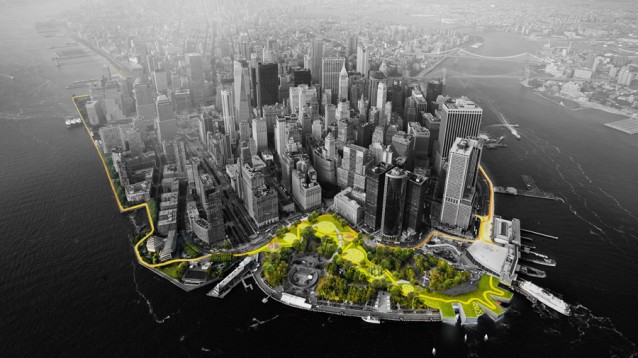New York and New Jersey were pummeled by Hurricane Sandy in 2012, but with the help of federal aid money, the two states are working to make sure they’re prepared next time extreme weather strikes.
The two states are receiving $920 million from the federal government, money that’s part of a $60 billion aid package awarded to Sandy-hit states to help them rebuild from the Superstorm. The $920 million is being distributed to resilience projects that were decided upon through a federal competition called Rebuild by Design. The competition awarded money to six projects, with the largest chunk going to a project called “the Big U,” which aims to build a 10-mile protective barrier around lower Manhattan. The point of the barrier, which will be composed of levees and berms, will be to protect the region from storm surge and flooding, but the project’s creators — architecture firm Bjarke Ingels Group — are also focusing on the utility and aesthetics of the wall, factoring in greenspace and protective walls that would be “decorated by neighborhood artists” into their proposal.
“Bridging Berm provides robust vertical protection for the Lower East Side from future storm surge and rising sea levels. The Berm also offers pleasant, accessible routes into the park, with many unprogrammed spots for resting, socializing, and enjoying views of the park and river,” the proposal’s creators write about a section of the wall. “Both berms and bridges are wide and planted with a diverse selection of salt tolerant trees, shrubs and perennials, providing a resilient urban habitat.”


Even after winning the competition, however, the Big U isn’t yet a done deal in Manhattan. The project’s creators are receiving $335 million from the federal government to build the first phase of the wall, an endeavor which will involve constructing a 1.5-mile, 10-to-20 feet tall earthen berm along the middle of Manhattan’s East River Park and FDR Drive, but the entire first phase will cost a total of about $1.2 billion. Amy Chester, a spokesperson for Rebuild by Design, said there wasn’t yet a timeline on when the project’s first phase would be completed.
Another of the winning Rebuild by Design projects will install breakwaters, or partially submerged barriers, off the south shore of Staten Island. The “Living Breakwaters” will dull the severity of storm surge and create new habitat for fish, oysters and lobsters. The proposal also plans on building a network of “water hubs” on the shore near the breakwaters. These would act as recreational parks, providing opportunities for kayaking and other activities in the calm water created by the breakwaters, along with providing space for birdwatching and outdoor classrooms and labs.
A third project aims to decrease the chances of flash flooding by installing a series of connected pumps and drainage routes that can capture and carry rainwater in Jersey City, Hoboken and Weehawken, New Jersey.
“Sandy was devastating, and frankly as a nation and as a region, we were unprepared. That won’t happen again, plain and simple, because of what we have done here today,” New York Sen. Charles Schumer (D), said at a news conference Monday.
The destruction of Hurricane Sandy gives New York and New Jersey some urgency in their drive to protect themselves from future storms, but they aren’t the only coastal states that are starting to prepare for sea level rise and the increased likelihood of extreme weather. In Southeast Florida, four counties are working to implement policies and strategies that will protect the region — which is one of the most vulnerable in the country to sea level rise — from flooding and storm surge. Though sea level rise and extreme weather are daunting challenges for these states and counties, there are strategies that have proven to be effective in helping regions adapt — healthy coral reefs, for instance, have been shown to reduce wave energy by 97 percent, so restoring coral ecosystems can also protect shorelines.
